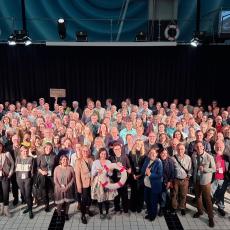Beneath the roaring jets lies a valley haunted by unending violence
This story was published and produced by Asia Democracy Chronicles.
Much of Indian-administered Kashmir was jolted awake one Tuesday night by blast-like sounds and low-flying jets. What began as an ordinary, quiet evening quickly turned into one filled with fear as chaos unfolded across the valley.
At 1:30 AM on May 8, India launched Operation Sindoor, hitting nine locations in Pakistan, including the Pakistan-occupied Kashmir. The strike that killed 26 and injured 46 came about just two weeks after the militant attack in the town of Pahalgam in the north Indian state of Jammu and Kashmir region, killing 28 and wounding dozens.
Ever since the Pahalgam incident, a sense of eerie silence had settled over Kashmir. There was no telling what would come next. But many residents felt that something was on the horizon. Before long, India’s retaliatory attack happened.
Panic immediately set in after the skies roared with the sound of fighter jets. In south Kashmir’s Pampore area, a fighter jet crashed shortly after midnight. The explosion was massive—residents as far as Srinagar, the region’s summer capital, heard the blast, and fire flashes lit up the sky. People nearby rushed to the streets and shared videos of the flames on social media.
“I was awakened by a loud sound and instinctively reached for my phone,” said a resident from south Kashmir, who requested anonymity. As he turned to social media, that’s when he learned that India had initiated the attacks.
“Sleep completely escaped me after that. My thoughts immediately went to friends and people living near the border. The panic from the past few days suddenly became very real,” he said.
For the affected civilians, war only brings suffering.
“As Kashmiris, we understand the pain of losing loved ones to bullets, torture, and violence. We’ve lived it. We don’t need a lecture on what war means; we carry it in our collective memory,” he recounted.
That night, many stayed awake to keep watch over their families.
“I was thinking that if anything happens, I’ll wake my family up. I was just anxious and keeping guard all night,” said a Srinagar resident.
When fear won’t go away
Hours later, both countries exchanged heavy artillery fire along the Line of Control (LoC), which divides the Indian and Pakistani parts of the Kashmir region. Many ended up dead and injured. Displaced and emotionally shattered families fled under gunfire with only the clothes on their backs. Border village residents spent nights in underground bunkers to survive the attacks.
As fear gripped the valley, social media became abuzz with rumors and speculations, and videos of the injured started pouring online.
“As Kashmiris, I think we’re born hyper-vigilant. It’s woven into our DNA,” said Marwa, 24, also from Srinagar.
She heard the first explosion at 1:30 a.m. while on the phone with a Kashmiri friend who couldn’t sleep due to the sound of fighter jets overhead. “When the explosion hit, the windows in my room rattled and for a moment, I couldn’t quite process what was happening,” said Marwa, who preferred to give only her first name.
Her first instinct was to go online and search “India Pakistan” under the news tab but thought otherwise.
“The next thing I did was wake everyone up … I just needed us all to be together,” she said, referring to her family.
The impact of the blast on her mental health holds little importance, she said. “When over half the population is dealing with some form of mental illness, my state of mind feels rather insignificant. And even if it did matter, what could possibly change?” Marwa tells Asia Democracy Chronicles (ADC).
“As always, we’re the ones who will be made collateral damage in a war we never wanted and suffer the consequences of decisions we never made,” she said.
Peace psychologist Ufra Mir said, “In conflict regions like Kashmir, the brain tends to stay in a state of hypervigilance. It’s constantly scanning for threats, always on edge. People already struggling with sleep disorders or anxiety are especially vulnerable.” Sudden triggers like jet flyovers, blasts, or even distant rumblings can activate the body’s survival mechanisms: fight, flight, freeze, or fawn, she added.
“This response releases cortisol, the stress hormone, leading to further emotional and physiological strain. For those with a history of trauma or post-traumatic stress or ongoing traumatic stress in places like Kashmir, such events can reopen old wounds,” Mir said.
“The uncertainty and lack of clear information only increase fear and helplessness. It disrupts sleep, reduces appetite, affects concentration, and causes emotional distress.”
Jubilation amid deep despair
As Kashmiris in and outside the region, and across the world, endured the night in fear and uncertainty, the reported airstrikes on Pakistan drew celebrations in various parts of India. People waved flags, distributed sweets, and chanted patriotic slogans. Hashtags like #IndiaStrikesBack flooded social media, TV channels ran celebratory coverage, and politicians across party lines praised Indian forces.
“What truly broke me was watching the celebration that followed in parts of India. People cheering for innocent lives lost—many of them Muslims—on both sides. It wasn’t patriotism; it was cruelty,” said the unnamed resident from south Kashmir. “This war is not just political—it has been communalized, weaponized for hate. And as usual, it’s the common people, especially Kashmiris and those near the borders, who are left to suffer while others turn our grief into memes and slogans.”
Individuals interviewed by ADC lamented reports of celebrations across the country amid Kashmiris’ suffering. “From all the corners of political ideologies—left, right, or center—everyone is cheering and asking for our suffering,” one resident said.
Kashmiris living in other parts of India said they, too, suffered from crippling anxiety. Families kept calling them well into the night, checking on their safety and urging them to return home, fearful they had been the targets of retaliation since the Pahalgam attack.
“My family kept calling me that night and eventually asked me to book my return tickets. They were scared for my safety,” said Umer Mukhtar, who works at a private company in New Delhi, India’s capital. “I told them I was fine, but they were scared. And so was I. But Kashmiris here had each other’s backs.”
Like everyone else, Anmol Kachroo, who lives just 20 kilometers from the Pakistan border in Jammu, said he, too, couldn’t sleep in the aftermath of the Indian strikes.
“I could hear sirens and then drones and helicopters all night. I opened Twitter [now X] and saw that India had attacked Pakistan. Then I couldn’t sleep at all, thinking that something would happen at any moment since Sialkot is only 15-20 km from my house,” he said.
Sialkot, a Pakistani city close to the border, was particularly concerning to Kachroo because if Pakistan had retaliated from there, his area in Jammu could have been hit, too.
Khalid Farooq, who works as an engineer in Qatar, recalled that fateful night. “I didn’t call my family when I heard about it as it was late. I kept waiting till it’s feasible so as to not let them know how panicked I was. I kept scrolling my timeline throughout … I thought of the worst possible outcomes,” he said.
On May 8, at 5:30 am, he finally called home and spoke with his father in Srinagar. The latter assured him they were fine and told him not to worry.
“Before hanging up, he said something that left me so angry and sad,” he said.
“Assi chu aadat gomut agar wen talluk peth hai karnas su gassi ha jaan. (We are used to such a situation. It would be better for us if they turned everything upside down).”
Mir, the psychologist, said that repeated exposure to violence doesn’t necessarily imbue one with strength.
“It often numbs people emotionally. Many Kashmiris may seem unfazed by the current situation, but that’s not because it’s normal; it’s because living in conflict has forced them to adapt to the ongoing trauma,” she said. “People’s resilience shouldn’t be romanticized, though. What others would consider shocking has become routine: gunfights, killings, detentions, curfews, and shutdowns.”
Anxiety-induced sleep disorders are reportedly widespread in Kashmir. “Many have been taking sleeping pills for years, some since the turbulent 1980s. Now, with the looming threat of a full-scale war between India and Pakistan, the existing mental health crisis in Kashmir is worsening,” she said.
Exacerbating the situation for Kashmiris struggling with the psychological toll of constant threats of attacks on both sides is the severe shortage of mental health professionals in the valley. “For a population this large and traumatized, there are far too few psychiatrists or psychologists. The lack of resources makes it harder for people to cope,” said Mir.
According to a 2011 census, only about 41 psychiatrists were available for the nearly 12.5 million population in Jammu and Kashmir at the time. As these data have yet to be updated, mental health issues remain underreported in the region despite widespread trauma, as studies show.
Jammu and Kashmir’s estimated population today is 13.7 million.
‘Normalcy’ narrative
Kachroo views Operation Sindoor— named after the red vermilion powder used by Hindu women as an auspicious symbol of their marital status—as an attempt by the Indian government to appease the ruling party’s support base, which was angered by the Pahalgam attack. The government’s “claims of ‘normalcy' in the valley were exposed (as a sham),” he said.
Purported increasing tourist numbers in Kashmir following the 2019 abrogation of Jammu and Kashmir’s partial autonomy were belied by the stark reality on the ground. Only a tenth of the reported tourist arrivals in Jammu and Kashmir since 2019 visited Kashmir Valley.
Just hours after the Pahalgam attack, hotels became empty, and meadows and gardens were deserted as tens of thousands of tourists left Kashmir.
According to a report by the International Journal of Advance Research in Science and Engineering, tourism’s contribution to Jammu and Kashmir’s Gross State Domestic Product (GSDP) varied between 6.99 percent and 8.04 percent in 2018 before the region lost its special status.
The government had hoped to double those numbers in a few years by opening more tourist spots—even in sensitive border areas, including Gurez, Keran, and Teetwal—to bolster the “normalcy narrative” that was set into motion after the revocation of Article 370 of India’s constitution, which accorded autonomy to Jammu and Kashmir. But the Pahalgam attack shattered that aspiration.
The 60-plus tourist locations launched after 2019 were shut down following the Pahalgam attack. With it, the goal of elevating the region’s contribution to the GSDP from 7 percent to 15 percent seemed so far away, as ’Boycott Kashmir’ calls emerged from across India. Some of these locations were recently opened as tourists returned.
Human cost
Kashmir has faced many uprisings, human rights violations, and violence for decades. Even after the Pahalgam attack, when Kashmir observed a complete shutdown, several protests and candle marches coupled with expressions of apology, were held across the region—they were still maligned. Many were assaulted in different states of India. There were calls for a boycott and an Israel-like solution for Kashmir.
Kashmiris felt the need to express sorrow and distance themselves from the incident, fearing collective punishment and further crackdowns by the Indian state.
Farooq, the Qatar-based Kashmiri engineer, pondered the Kashmiri people’s profound sense of helplessness:
“We are thrown into this bloody war against our will." Throughout the day, I was processing that one call with my father and those words he said.
“I, as a Kashmiri, have never felt so cursed. We don’t deserve this. We deserve better. We deserve a better life than living under a fear of stray bullets and hovering missiles.”
Beyond the headlines, political rhetoric, and state narrative, Kashmiri people have been bearing the brunt of two countries locked in a long, drawn-out conflict. “No matter what happens between India and Pakistan, it’s the people of Kashmir who will pay the price,” Mir said.



